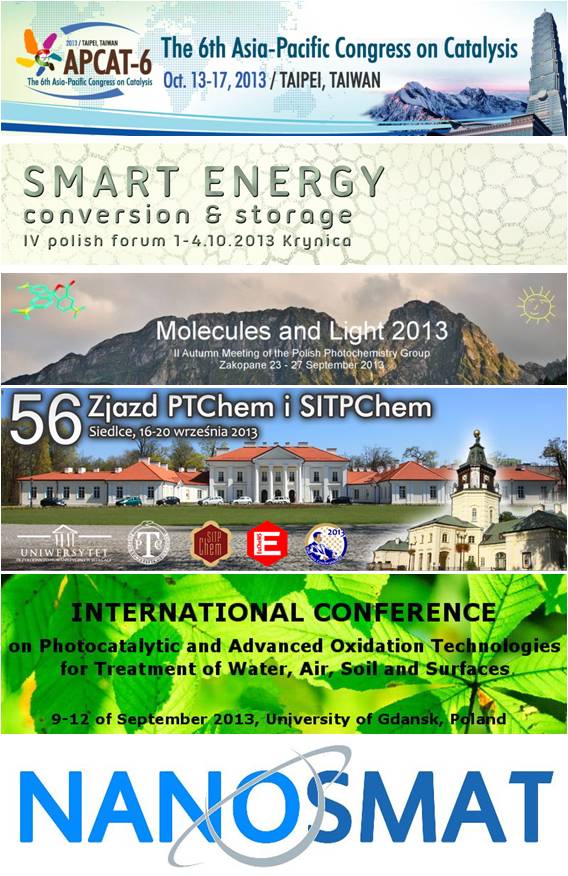 General
General
Conferences
In September and October our results were presented at several conferences in Poland and abroad:

 General
General
In September and October our results were presented at several conferences in Poland and abroad:

 General
General
The second recruitment procedure has been finished and the new TEAM members have been selected:
Dr. Kezhen Qi (post-doc)
Kacper Pilarczyk (student)
Małgorzata Kubiak (student)
Michał Kawa (student)
We would like to acknowledge everybody who applied. The last recruitment will be announced in spring 2014.
 General
General
Dr. Joanna Kuncewicz came back after a long (30 months) post-doctoral leave to Sapporo, Hokkaido University (group of Prof. Bunsho Ohtani).
 Marta Buchalska
Marta Buchalska
Marta Buchalska has got her PhD degree. Congratulation!
High photocatalytic activity upon irradiation with UV light is one of major advantage of TiO2. This material can also be easily modified and sensitized to be active in visible light range. Especially modification with organic compounds that contain O-donor bonding groups often leads to stable and colorful charge transfer complexes. The aim of this study was to determine the mechanisms of photoinduced charge and energy transfer processes, that occur in presence of colloidal, nanocrystalline TiO2 with modified surface. An additional objective was to determine the influence of the structure of the modifier, crystalline form of TiO2 and the type of radiation (Uv, visible, NIR) on the relative efficiencies of these processes. Colloidal, nanocrystalline anatase and rutile (from NanoAmor) were used during this work. The surface of materials was modified with the derivatives of catechol, salicylic acid and phthalic acid. Absorption and emission spectra were measured for all the samples, as well as electrochemical and spectroelectrochemical studies. Photocatalytic activity of the materials was determined upon irradiation with various light ranges (UV, visible, UV-Vis, NIR) and with various substrates (p-chlorophenol, Azur B). Unexpectedly high photocatalytic activity of all materials was observed upon irradiation with UV-vis light. Degradation rates are higher than sums of the effects observed separately for UV and visible light. Upon excitation of both, the semiconductor (with UV light) and the surface complex (with visible light), the oxidized form of the ligand can be reduced back by electrons from the conduction band. Presumably, this process inhibits electron-hole recombination and leads to an increase of the lifetimes of valence band holes and TiIII-centre of the excited surface complex. Increased lifetimes improve efficiencies of interfacial electron transfer process. The possibility of singlet oxygen generation was confirmed in direct measurements of phosphorescence at = 1270 nm upon excitation at = 355 nm. In this conditions 1O2 was detected in presence of unmodified anatase and material modified with salicylic acid. The efficiency of this process is F = 1,2 ± 0,5 for modified material and is about 3 times lower for unmodified anatase. The presence of singlet oxygen was also determined by monitoring the process of photooxidation of SOSG. The oxidized form of this compound shows high emission in visible light range. Tests were performed upon irradiation with monochromatic (laser l = 405 nm) and bichromatic light (additional l = 355 nm or l = 785 nm laser). It was shown that upon irradiation with l = 405 nm, singlet oxygen is generated in so called modified Nosaka’s mechanism. In this process photogenerated superoxide radical is oxidized to 1O2 by oxidized form of the surface complex. Upon additional irradiation with l = 785 nm, singlet oxygen can be generated in the process of energy transfer from the high excited state of the electron in the conduction band. TiO2 in anatase form shows higher photocatalytic activity than materials containing rutile. The highest efficiency of hydroxyl radical generation was determined for anatase modified with catechol. Salicylic acid modified anatase was the most active in the process of singlet oxygen generation.